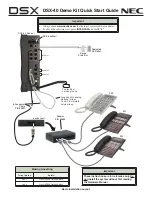
119
Glossary
Gigaset DX600A isdn / IM-OST EN / A31008-N3101-R601-1-7619 / Glossary.fm / 05.03.2010
V
e
rsion 4, 16.0
9
.2005
Glossary
A
Authentication
Restriction of access to a network/service by
use of an ID and password to log in.
Automatic ringback
See
Ringback when the number is busy
.
B
Block dialling
Enter the complete phone number, and cor-
rect it if necessary. Then pick up the handset
or press the handsfree key to dial the phone
number.
Broadband Internet access
See
C
Call waiting
= CW.
Network provider feature. A beep during a
call indicates that another caller is waiting.
You can accept or reject the second call. You
can activate/deactivate the feature.
Call divert
=
CD
Automatic diversion (CD) of a call to a differ-
ent telephone number. There are three kinds
of call divert:
– CDU, Call Divert Unconditional
– CDB, Call Divert Busy
– CDNR, Call Divert No Reply
Call swap
Call swap allows you to switch between two
callers or between a conference and an indi-
vidual caller without allowing the waiting
caller to listen to the call.
Client
Application that requests a service from a
server.
Codec
Coder/decoder
Codec is a procedure that digitises and com-
presses analogue voice before it is sent via
the Internet, and decodes – i.e., translates
into analogue voice – digital data when
voice packets are received. There are differ-
ent codecs, with differing degrees of com-
pression, for instance.
Both parties involved in the telephone con-
nection (caller/sender and recipient) must
use the same codec. This is negotiated
between the sender and the recipient when
establishing a connection.
The choice of codec is a compromise
between voice quality, transmission speed
and the necessary bandwidth. A high level
of compression, for example, means that the
bandwidth required for each voice connec-
tion is low. However, it also means that the
time needed to compress/decompress the
data is greater, which increases execution
time for data in the network and thus
impairs voice quality. The time required
increases the delay between the sender
speaking and the recipient hearing what has
been said.
COLP/COLR
Connected Line Identification Presentation/
Restriction
Feature provided by a ISDN connection for
outgoing calls.
COLP displays the phone number accepting
the call on the calling party's display unit.
The number of the party accepting the call is
different to the dialled number e.g., if the call
is diverted or transferred.
The called party can use COLR (Connected
Line Identification Restriction) to prevent
the number from appearing on the calling
party's display.
















































